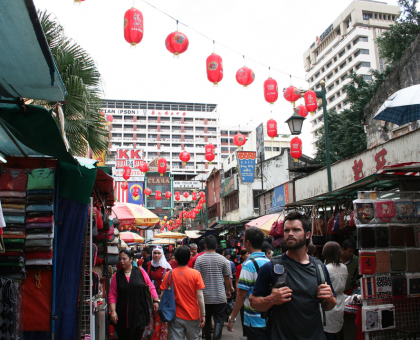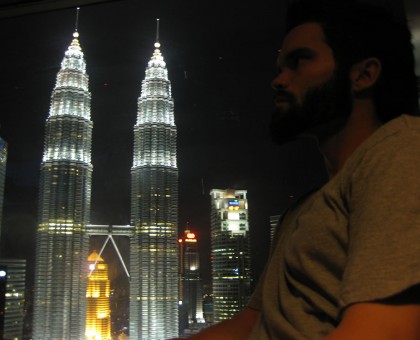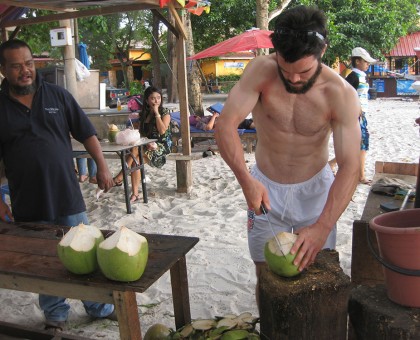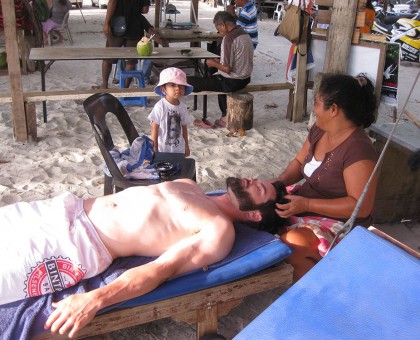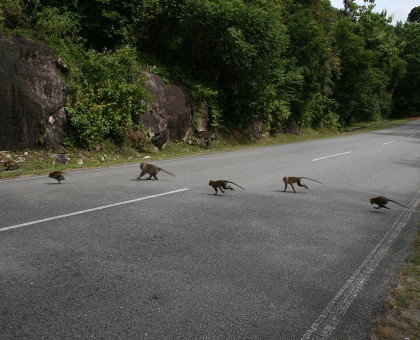.png)
I will be hard-pressed to find somewhere as remarkable as Malaysia.
The broad range of culture in this Southeast Asian country is incredible, so my experiences were extremely diverse.
Flying into Malaysia's capital of Kuala Lumpur - a city of 1.5 million inhabitants - put me on the Peninsular Malaysia, which is separated from Malaysian Borneo by the South China Sea. K.L. is a bustling, vibrant melting pot that offers a true taste of Asia. Extravagant temples are scattered through the city, tall towers stand out in the middle of the central business district and tiny markets line K.L.'s streets, offering inexpensive food and trinkets. I had a few volleys of badminton with a couple local Malaysian kids, which was spontaneous and really special. The kids loved it.
Wanting to take in the full Islamic experience, I sourced a Muslim prayer cap - known as a kopiah in Malaysia - and a sarong, a large tube or length of fabric, often wrapped around the waist and worn by men and women throughout much of Southeast Asia. Islamic cultures throughout Southeast Asia and the Middle East have different names for this clothing, so it was interesting learning their names in Malaysia. Attending prayer sessions at the National Mosque of Malaysia was a fascinating experience, and although it meant nothing to me religiously, simply being present was enlightening. The elaborate mosque, with its immaculate marble and pristine carpet, certainly created a surreal atmosphere for anyone present.
Visiting the Batu Caves, a Hindu shrine and a tourist attraction just outside K.L., was quite the all-around Malay adventure. Before embarking on the 272-step staircase up to reach the caves' entrance, my eyes were fixed on a 42m (140ft) high statue of Murugan, a Hindu deity. The statue is enormous! Painted with more than 300 liters (79 gallons) of gold paint from Thailand, this enormous piece took three years to construct and is the tallest Lord Murugan statue in the world.
As I made my way up the 272 steps, it was about midway up when I began noticing some friendly creatures engaging with locals and tourists alike. Lining the steps, gawking and squealing in unpleasant tones - almost as if those trudging up the steps were models strutting the catwalk - these long-tailed creatures certainly stole the show. If I didn't know better, they were the tourist attraction. These furry varmints seemingly posed a threat to visitors, and I had been warned of the dos and don'ts when coming into contact with them. What were they? Monkeys. And hundreds of them. In the trees, beneath my feet, running up the steps and constantly yapping. They wouldn't shut up. Carrying nothing but my camera - knowing that any loose articles (especially a hat or bag) were subject to be stolen right out of my hands - I had my head on swivel. I purposely engaged with some monkeys, and enticed them with apple bananas so they would come closer. These monkeys are extremely territorial, so I had to part ways with several apple bananas simply so I wouldn't lose my finger…or hand.
Once I finally reached the inside of the Batu Caves, I was in the heart of three main caves and a few smaller ones. The biggest, referred to as Cathedral Cave or Temple Cave, has a very high ceiling and features ornate Hindu shrines. Monkeys are less prevalent here, but once I headed up and out of Cathedral Cave, they were back. Scaling rock facings and scurrying across the ground, a pause or stop button didn't seem to be a thought.
After escaping the Batu Caves, I returned to the city and headed to the KL Tower. Having a clear, 360-degree view of Kuala Lumpur and all of its surroundings was great. In plain view were the Petronas Towers, where the headquarters of the national oil company Petronas is located. The towers are the tallest twin towers in the world, and are marvelous structures. Once I left the 335-meter (1,100-foot) KL Tower, I headed down to street level and over to the Petronas Towers. As one would imagine, my neck was sore after gawking 452m (1,482ft) up to the top of the towers.
Playing with iguanas at the base of the KL Tower was random, but memorable.
A visit to the Thean Hou Temple - a six-tiered Chinese temple in the heart of K.L. - added to my Malaysian cultural encounters.
Once the sun went down, I ventured to the Traders Hotel and up to the 33rd floor where I stepped into the SkyBar. Most known for its views of the Petronas Towers, the SkyBar is no dive, but one could dive while there. Featuring an indoor pool surrounded by comfortable sofas and chairs, the SkyBar is the spot on the K.L. social scene. Its views of the lit up Petronas Towers are incredible.
Ready for something different, my next Malaysian port of call was Langkawi. A cluster of 99 islands separated from mainland Malaysia by the Malacca Strait, Langkawi is located 30 km (18mi) off the mainland coast of northwestern Malaysia and features an abundance of beauty and luxury. At Cenang Beach alone, I was able to pull my own coconut from a tree, chop it and then drink the milk from within. Talk about culture!
Staying at Awana Porto Malai kept me tucked away from the hustle and bustle of Cenang, Langkawi's most popular island attraction, and offered a tranquil place to call 'home'. A massage on the beach was super relaxing, strolling around Cenang on a mo-ped made me feel more Asian than I've ever felt and interacting with authentic Malaysian dancers and singers only enhanced the experience on Langkawi.
I borrowed a car from one of the staff members at the resort, and decided to explore the island. Without a map or GPS, and relying solely on local advice and the occasional road sign, I circumnavigated the island. Coming across dozens wild monkeys felt like a scene from Jumanji, and having to dodge Malaysian buffalo crossing the road made for a bizarre challenge. Although rather commercialized, the Langkawi Cable Car is one of the main attractions on the island, and before the ascent, tourists can visit local stalls and shops and purchase inexpensive clothing or Malaysian gifts.
My next stop was at Tanjung Rhu Beach, which was breathtaking. Hidden from the rest of the world, this (nearly) private beach is perhaps one of the most beautiful beaches in Malaysia and could be one of the best in the world. It is fringed by silvery sands, lush forests, pristine waters and overlooking some of Malaysia's dreamy islands. Situated at the northernmost tip of the island, views out to the Andaman Sea are extraordinary. The water is warm, shallow and so inviting.
As my journey around the island continued, I arrived at the quaint port town of Kuah. This gorgeous southeastern town is known for Eagle Square, or "Dataran Lang." Within Eagle Square is a huge monument in the shape of a sea-eagle in a pre-flight pose perched on some rocks. The huge 12-meter (39-foot) high statue greets visitors who come to Kuah by ferry. The eagle is symbolic of Langkawi Island as its name derives from the Malay word for eagle.
Sunset in Kuah brought a busy day of travel to a peaceful end.






